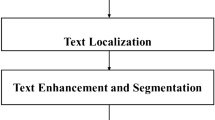Abstract
Currently, many researchers have paid more attention to identifying scene texts from the image with background interferences. This study aims to develop an App software system with text recognition on smartphones. Otsu edge detection is applied to binarize the image and to find the parameters (i.e. weights) in a K-cluster. The modified K-cluster algorithm is used to detect the text from an image. The noise in complex background is also filtered out. The detected text gradients are evaluated by histogram of gradient. Accordingly, the distribution of the detected text gradients is generated. Finally, the gradient distribution is utilized by hidden Markov models to recognize the text. The experimental results have shown that the proposed approach can successfully outperform other methods.




















Similar content being viewed by others
References
Liang, J., Doermann, D., & Li, H. (2005). Camera-based analysis of text and documents: A survey. International Journal on Document Analysis and Recognition,7(2–3), 84–104.
Jung, K., Kim, K., & Jain, A. (2004). Text information extraction in images and video: A survey. Pattern Recognition,37(5), 977–997.
Judd, T., Ehinger, K., Durand, F., & Torralba, A. (2009). Learning to predict where humans look. In Proceedings of IEEE 12th ICCV (pp. 2106–2113).
Chen, X., & Yuille, A. (2004). Detecting and reading text in natural scenes. Proceedings of IEEE CVPR,2, 366–373.
Neumann, L., & Matas, J. (2012). Real-time scene text localization and recognition. In Proceedings of IEEE CVPR (pp. 3538–3545).
Neuman, L., & Matas, J. (2010). A method for text localization and recognition in real world images. In Proceedings of ACCV (pp. 770–783).
Odobez, J. M., & Chen, D. (2002). Robust video text segmentation and recognition with multiple hypotheses. In Proceedings of ICIP (pp. 433–436).
Huang, R., Oba, S., Shivakumara, P., & Uchida, S. (2012). Scene character detection and recognition based on multiple hypotheses framework. In Proceedings of ICPR (pp. 717–720).
Jetley, S., Behlhe, S., Koppula, V. K., & Nagi, A. (2012). Two-stage hybrid binarization around fringe map based text line segmentation for document images. In Proceedings of ICPR (pp. 343–346).
Zhang, D., & Chang, S. (2003). A bayesian framework for fusing multiple word knowledge models in videotext recognition. In Proceedings of CVPR (pp. 528–533).
Lucas, S. M. (2005). Text locating competition results. In Proceedings of third international conference on document analysis and recognition (pp. 80–85).
Gao, Song, Wang, Chunheng, Xiao, Baihua, Shi, Cunzhao, Zhou, Wen, & Zhang, Zhong. (2015). Scene text recognition by learning co-occurrence of strokes based on spatiality embedded dictionary. IET Computer Vision,9, 138–148.
Koerich, L., Sabourin, R., & Suen, Y. (2005). Recognition and verification of unconstrained handwritten words. IEEE Transactions on Pattern Analysis and Machine Intelligence,27(10), 1509–1522.
Pedro Felipe Felzenszwalb. Introduction to computer vision edge detection [Online]. https://www.classes.cs.uchicago.edu/archive/2008/spring/35040-1/edges.pdf. Accessed 2 June 2017.
Utrecht University. Chapter 10 segmentation [Online]. http://www.cs.uu.nl/docs/vakken/ibv/reader/chapter10.pdf. Accessed 11 July 2017.
Seo, Joung-Hae, & Park, Eun-Mi. (2018). A study on financing security for smartphones using text mining. Wireless Personal Communications,98(4), 3109–3127.
Wikipedia. Histogram of oriented gradients [Online]. https://en.wiki-pedia.org/wiki/Histogram_of_oriented_gradients. Accessed 11 July 2017.
Dietterich, Thomas, Bishop, Christopher, Heckerman, David, Jordan, Michael, & Kearns, Michael. (2010). Introduction to machine learning (2nd ed.). London: The MIT Press.
Cheng, F., Zhang, H., Fan, W., & Harris, B. (2018). Image recognition technology based on deep learning. Wireless Personal Communications,102(2), 1917–1933.
Rabiner, L. R. (1989). A tutorial on hidden Markov models and selected applications in speech recognition. Proceedings of IEEE,77(2), 257–285.
Young Jung Kim and Jong Yun Lee. (2016). Algorithm of a perspective transform-based PDF417 barcode recognition. Wireless Personal Communications,89(3), 893–911.
Davis, R. I. A., Lovell, B. C., & Caelli, T. (2002). Improved estimation of hidden Markov model parameters from multiple observation sequences. Proceedings International Conference on Pattern Recognition,2, 168–171.
Baggenstoss, P. M. (2001). A modified Baum–Welch algorithm for hidden Markov models with multiple observation spaces. IEEE Transactions on Speech and Audio Processing,9, 411–416.
Wang, K., Babenko, B., & Belongie, S. (2011). End-to-end scene text recognition. In Proceedings ICCV (pp. 1457–1464).
Otsu, N. A. (1979). Threshold selection method from gray-level histograms. IEEE Transactions on Systems, Man, and Cybernetics,9(1), 919–926.
Abbyyfinereader 9.0. http://www.abbyy.com. Accessed 11 July 2017.
Acknowledgements
The authors are very grateful to the anonymous reviewers for their constructive comments which have improved the quality of this paper. Also, this work was supported by the Ministry of Science and Technology, Taiwan, under grant MOST 106- 2221- E-845- 001.
Author information
Authors and Affiliations
Corresponding author
Additional information
Publisher's Note
Springer Nature remains neutral with regard to jurisdictional claims in published maps and institutional affiliations.
Rights and permissions
About this article
Cite this article
Shen, V.R.L., Chiou, GJ., Lin, YN. et al. Novel Text Recognition Based on Modified K-Clustering and Hidden Markov Models. Wireless Pers Commun 111, 1453–1474 (2020). https://doi.org/10.1007/s11277-019-06926-6
Published:
Issue Date:
DOI: https://doi.org/10.1007/s11277-019-06926-6




